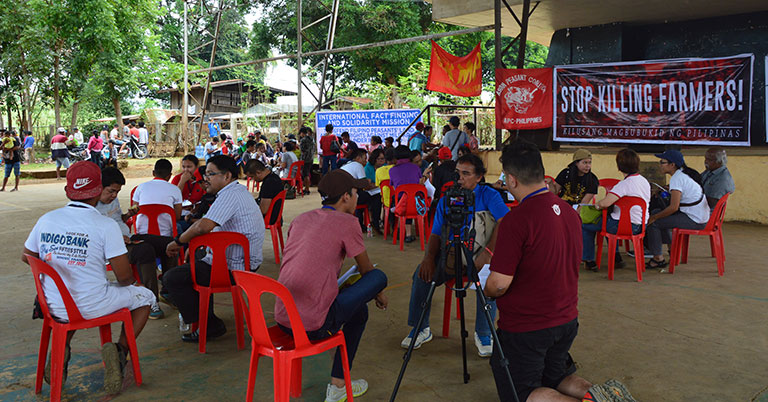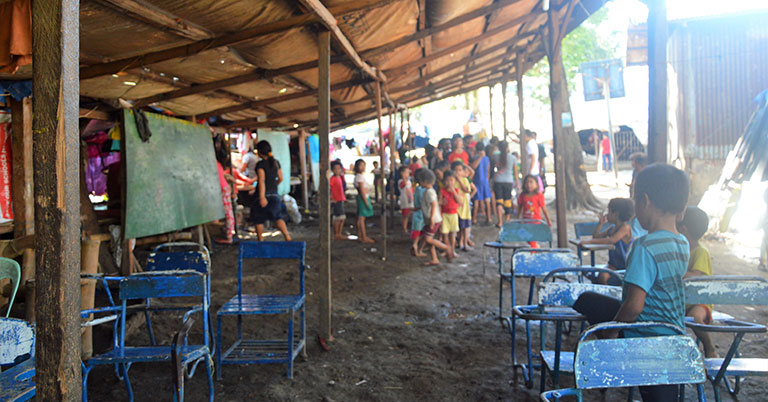On April 6-9, 2018, PAN Asia Pacific (PANAP) joined an international fact-finding and solidarity mission (IFFSM) in Mindanao organized by the Kilusang Magbubukid ng Pilipinas or Peasant Movement of the Philippines (KMP). Here is our account, describing how war, militarization and martial law have made life precarious for the youth and children in Mindanao.
They heard them before they saw them. Cousins Daniel, Joshua, James, and Mark * – all in their teens – were working in their family farm in Sitio Lino, Malapatan in Sarangani (a province in Mindanao, Philippines) around noon on March 27 when they heard the whir of rotor blades and looked up to see two helicopters approaching their location. A few seconds later, the helicopters – which they then realized belong to the Philippine Army and were packed with heavy machine guns – hovered over them, and the four barely had time to think before they had to run for their lives.
It was a mystery to them how they survived: More than a hundred empty gun shells were recovered in the area and they only had a huge boulder to protect them from the onslaught of bullets.
It was an even bigger mystery to them why the helicopters fired at them: “Mag-uuma lang kami,” (We are just farmers) Daniel said.

Children in the time of war and militarization
Bullets and bombs do not discriminate, and they often target and devastate the most vulnerable.
In times of war and militarization, the children and the youth are subjected all types of atrocities and all forms of violence, not least of all of strafing and indiscriminate firing, wherein they can become casualties or sustain serious injuries. They are exposed to such horrors as the destruction of their houses, the death of their loved ones, or separation from their families. They are made to flee their communities, to suffer from hunger, and to do nothing but anxiously wait for the time they can go back home.
The children and the youth in Mindanao in southern Philippines, where there are currently 71 military battalions that occupy civilian homes and communities in the name of “peace,” know these very well. But like Daniel, Joshua, James, and Mark, they have no idea why.
Mindanao is rich in land, natural and mineral resources. But is also home to many struggles of farmer and lumad (indigenous peoples of Mindanao) communities for their right to land and self-determination, and site of many state-sponsored human rights violations, done to protect corporate interest as well as to secure new areas for land-intensive domestic and foreign investment, under the government’s counter-insurgency programs, the latest of which is the Duterte regime’s Oplan Kapayapaan. Ironically, kapayapaan is the Filipino word for peace, something that has eluded the country’s rural communities especially in Mindanao.
In its 2017 Yearend Report on the Human Rights Situation in the Philippines, human rights group Karapatan maintains that from the start of the Duterte regime in July 2016 to December 2017, 110 farmers had been victims of extrajudicial killings (EJK). Eighty or 63% were from Mindanao, where farmers and lumads still have to assert their right to land granted to them under the agrarian reform program against local landlords who continue to claim and control them, and where conflicts also arise from the encroachment on their agricultural land and ancestral domains by domestic and foreign interests looking to acquire huge tracts of land for large commercial plantations and for extractive and exploitative ventures.
The already bloody situation in Mindanao only got bloodier when President Rodrigo Duterte placed the country’s second largest group of islands under martial law in May 2017 after an armed conflict sparked between the AFP and the reportedly Islamic State (IS)-affiliated Maute Group in Marawi City.
The number of combat troops deployed in Mindanao increased, and with this, the number of human rights violations against farmers, indigenous peoples, and the rural population: the first six months after the declaration saw 29 victims of EJKs, many of whom were affiliated with KMP; 58, illegal arrests and detention; and 335,686, indiscriminate firing and aerial bombing of civilian communities, according to Karapatan.
The findings of the four-day Stop Killing Farmers: An International Fact-Finding Mission to Defend Filipino Peasants’ Land and Human Rights against Militarism and Plunder in Mindanao organized by the Kilusang Magbubukid ng Pilipinas (Philippine Peasant Movement or KMP) which PAN Asia Pacific (PANAP) joined on April 6-9, supported this. In the Caraga region, for instance, from two documented cases of EJKs before martial law, the number jumped to seven since military rule was imposed.

Red-tagging the innocent
Red-tagging has always been a practice among the military to justify the violence and abuses they commit against the civilian population. In 2007, nine-year-old Grecil Buya was killed by the 1001st Infantry Battalion of the AFP in Compostela Valley. She was tagged as a child soldier the rebel group New People’s Army (NPA), after an M16 rifle, a firearm more than half of Grecil’s weight, was allegedly found beside her lifeless body.
The practice has become more common now. Anyone can be tagged arbitrarily by the military as being a member or sympathizer of the NPA. Ordinary rural folks are forced to “surrender” as part of a military campaign that terrorizes communities, and which according to KMP is being used to “deceive the general public to create the impression that the military is winning the war against the communist insurgents.” No one is spared, not even the youth.
Fifteen-year-old high school student Jenny * was among those tagged a “rebel” by the military. Early morning on March 2, the AFP Special Forces aboard two what the locals call “6×6” (heavy duty off-road trucks) forcibly entered her family’s house in Sitio Patpat, Malaybalay City in Bukidnon (also a Mindanao province), and dragged her, with her 22-year-old brother and his 18-year-old pregnant wife, into the trucks. The soldiers held no warrant of arrest, and threatened to kill the Jenny’s family if she refuse to peacefully “surrender”.
Handcuffed, blindfolded, and bruised from when the soldiers manhandled her, she was transported to an encampment in another village where she was continuously interrogated and repeatedly threatened to force her to “confess” being a member of the NPA. At one point, one of her interrogators hit her in the forehead. At another, they placed the barrel of a gun in her mouth.
Jenny and her family were active members of Pinagyayungaan, a local organization of lumads involved in land struggles in Northern Mindanao and affiliated with the Kalumbay Regional Lumad Organization. They had been “bakwits” (colloquial term for evacuees) forced from their home in the remote Sitio Kilap-agan, also in Malaybalay, Bukidnon, in 2015 by the spate of human rights violations committed by the Dela Mance Brothers, a local paramilitary group allegedly being used by the AFP against the NPA and were responsible for the deaths of several lumad activists in the province of Bukidnon.
Bakwit children of Mindanao
While waiting for the shuttle that would take the IFFSM participants to the venue where the initial findings of the mission will be presented to the members of the press in Davao City the morning of April 9, around a dozen children rehearsed a cultural performance for their upcoming moving up ceremony later that week. They were grade school students of the Mindanao Interfaith Services Foundation Inc. Academy (MISFI) – an alternative learning institution for lumad children – in Kapalong, Davao del Norte but who, along with their families, had been forced to walk almost a hundred kilometers away from their home after the paramilitary group Alamara (another alleged AFP-sanctioned paramilitary group) started wrecking havoc in their communities in 2015. They have been staying temporarily in a shelter set up by the United Church of Christ in the Philippines (UCCP) in Haran, Davao City.

The volunteer teachers of MISFI try their best to educate the children despite the difficult environment at the evacuation center. But the lack of proper facilities (the makeshift classrooms are just a few feet away from the bakwits’ temporary houses on the one side and a busy road on the other), very limited school supplies including textbooks for the students and reference materials for the teachers, as well as, the lack of safe environment and proper nutrition, make it extremely difficult for the children to concentrate on and learn the lessons. “This is not the type of environment children should play, study, and grown in,” volunteer teacher Myra * said.
Forced evacuations did not only continue, but increased under Duterte and his martial law. According to Karapatan, “More than previous presidencies, the Duterte regime has displaced the highest number of people in the year and a half of his term.” Around half a million people had no choice but leave their communities due to military combat operations and occupation of rural communities by combat troops.
In November 2017, 1,173 individuals were forced to flee their homes due to military combat operations in their communities in Lianga and San Agustin, Surigao del Sur. Around 406 lumad students and 59 volunteer teachers of nine lumad schools were also affected. A few months earlier, in July, six lumad schools forcibly closed when soldiers entered Lianga, affecting 663 lumad students and 43 volunteer teachers. Attacks on schools intensified after President Duterte threatened to bomb lumad alternative learning schools after branding them as illegal and “teaching communism” one day after his second State of the Nation Address in 2017.
Students and teachers experienced all types of abuses and harassment in the hands of the military and paramilitary. On September 5, two paramilitary men shot Obillo Bay-ao, a 19-year-old Grade 6 student of the Salugpongan Ta’Tanu Igkanugon Community Learning Center (STTICLC) in Talaingod, Davao del Norte. He was among the 200 evacuees who fled their homes in July following the threat of the Alamara to burn down the alternative school. He had just returned home barely a week after participating in the “Lakbayan ng Pambansang Minorya” in Manila to demand the pullout of military troops in rural communities and the lifting of martial law in Mindanao, when he was attacked.
“We just want to go to school”
It is the right of every person to have a healthy, safe, and happy childhood. Principle 2 of the Declaration of the Rights of the Child, states that every child shall enjoy special protection to enable her/his holistic development “in a healthy and normal manner and in conditions of freedom and dignity.” The situation and conditions brought forth by increased militarization and the imposition of martial law in Mindanao not only deny the children of Mindanao this right but also blatantly violate it. Under Duterte’s martial law and counter-insurgency program Oplan Kapayapaan, the children of Mindanao live in constant fear and possible lifetime of trauma.

“Gusto namin bumalik pero paano kami uuwi? Nandoon pa rin yung Alamara. Kung uuwi kami, babalik din kami dito kasi hindi humihinto yung harassment nila sa amin” (We want to go back home but how? The Alamara remains in our community and the continues to harass us), lamented 15-year-old Isay, a graduate of MISFI. She shared how earlier this year, “Kuya Arot” (Garito Malibato; “kuya” is a Filipino term of endearment for an older brother) decided to come back home to tend to his gravely ill mother who remained in Kapalong despite the continued presence of the Alamara. The paramilitary group wasted no time in accusing him of being a member of the NPA. The 23-year-old was gunned down on March 22. His mother succumb to her illness not long after.
“Gusto namin na makauwi na kami. Gusto naming malayang makapag-aral” (We want to go home. We want to go to school), said Isay, who hopes that soon, the Alamara and the military will be gone from their community, and that martial law will be lifted so that she, her friends and her family can go back to their land and get back their life. #
*Not their real names

#NoLandNoLife Features discuss recent developments, events, and trends on land and resource grabbing and related human rights issues in the region as well as the factors and forces that drive it. Send us your feedback at nolandnolife@panap.net.








Discussion about this post